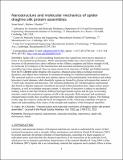Nanostructure and molecular mechanics of spider dragline silk protein assemblies
Author(s)
Keten, Sinan; Buehler, Markus J
Downloadpaper_JRS_Interface_2010_FINAL.pdf (2.527Mb)
OPEN_ACCESS_POLICY
Open Access Policy
Creative Commons Attribution-Noncommercial-Share Alike
Terms of use
Metadata
Show full item recordAbstract
Spider silk is a self-assembling biopolymer that outperforms most known materials in terms of its mechanical performance, despite its underlying weak chemical bonding based on H-bonds. While experimental studies have shown that the molecular structure of silk proteins has a direct influence on the stiffness, toughness and failure strength of silk, no molecular-level analysis of the nanostructure and associated mechanical properties of silk assemblies have been reported. Here, we report atomic-level structures of MaSp1 and MaSp2 proteins from the Nephila clavipes spider dragline silk sequence, obtained using replica exchange molecular dynamics, and subject these structures to mechanical loading for a detailed nanomechanical analysis. The structural analysis reveals that poly-alanine regions in silk predominantly form distinct and orderly beta-sheet crystal domains, while disorderly regions are formed by glycine-rich repeats that consist of 31-helix type structures and beta-turns. Our structural predictions are validated against experimental data based on dihedral angle pair calculations presented in Ramachandran plots, alpha-carbon atomic distances, as well as secondary structure content. Mechanical shearing simulations on selected structures illustrate that the nanoscale behaviour of silk protein assemblies is controlled by the distinctly different secondary structure content and hydrogen bonding in the crystalline and semi-amorphous regions. Both structural and mechanical characterization results show excellent agreement with available experimental evidence. Our findings set the stage for extensive atomistic investigations of silk, which may contribute towards an improved understanding of the source of the strength and toughness of this biological superfibre.
Date issued
2010-06Department
Massachusetts Institute of Technology. Center for Computational Engineering; Massachusetts Institute of Technology. Department of Civil and Environmental Engineering; Massachusetts Institute of Technology. Laboratory for Atomistic and Molecular MechanicsJournal
Journal of the Royal Society Interface
Publisher
The Royal Society
Citation
Keten, Sinan, and Markus J. Buehler. “Nanostructure and molecular mechanics of spider dragline silk protein assemblies.” Journal of The Royal Society Interface (2010).
Version: Author's final manuscript
ISSN
1742-5689